Case Study: Safety Breaches in the Waterfall Train Accident
VerifiedAdded on 2022/10/11
|10
|2082
|14
Report
AI Summary
This report presents a case study of the Waterfall rail accident in Australia, analyzing the safety breaches that led to the tragic derailment. The report details the incident, including the train's derailment due to the driver's heart attack and excessive speed on a curve, and the guard's failure to apply the emergency brake. It identifies vulnerabilities in the safety system, such as the deadman's brake and the lack of a backup safety system, along with the human factors contributing to the accident. The report further outlines the changes implemented after the accident, including the task-linked vigilance system and data loggers, and suggests improvements such as a vigilance system for the guard and stricter quality control measures to prevent similar incidents. The analysis emphasizes the importance of both technological and human factors in ensuring railway safety, making it a valuable resource for students studying risk management and safety.
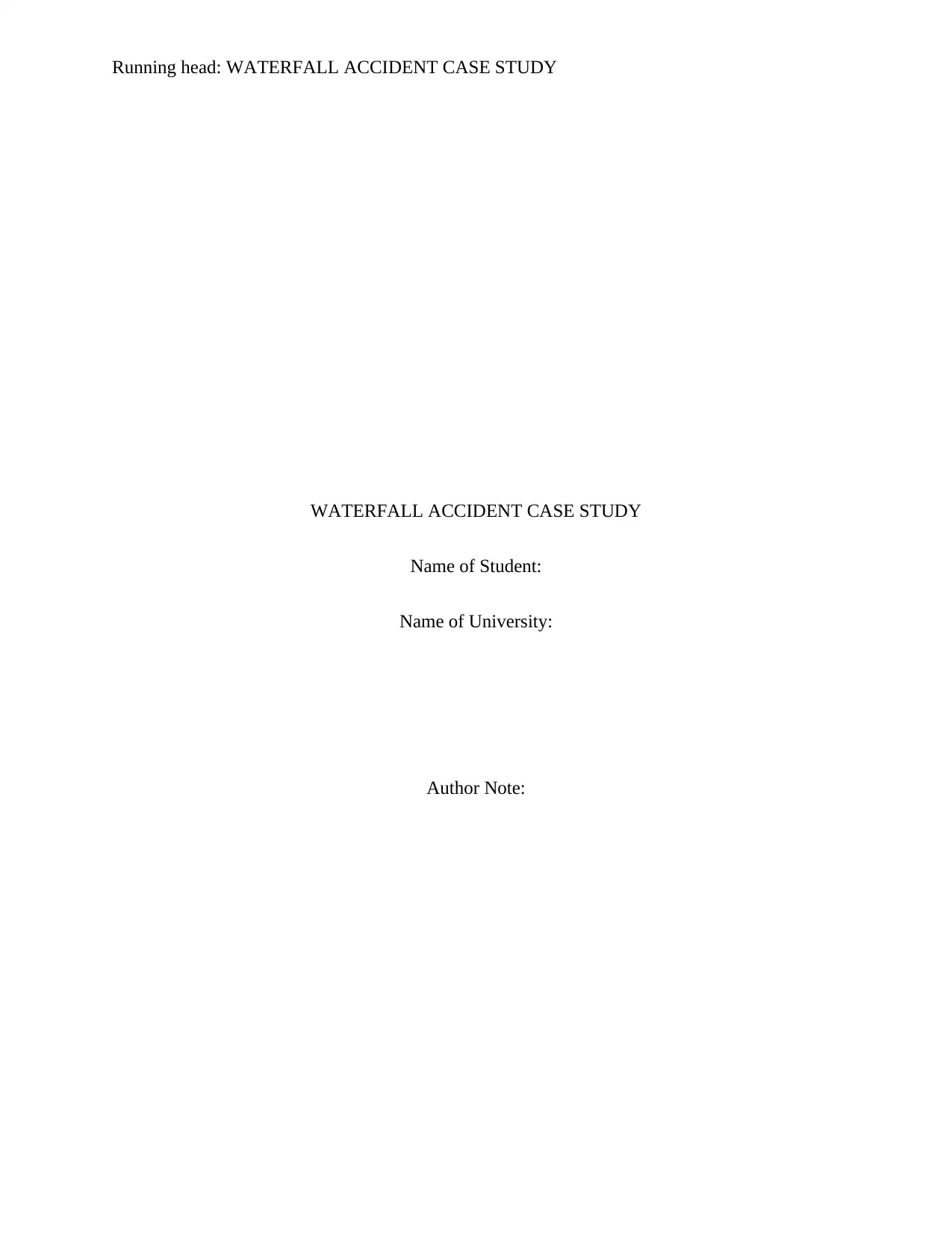
Running head: WATERFALL ACCIDENT CASE STUDY
WATERFALL ACCIDENT CASE STUDY
Name of Student:
Name of University:
Author Note:
WATERFALL ACCIDENT CASE STUDY
Name of Student:
Name of University:
Author Note:
Paraphrase This Document
Need a fresh take? Get an instant paraphrase of this document with our AI Paraphraser
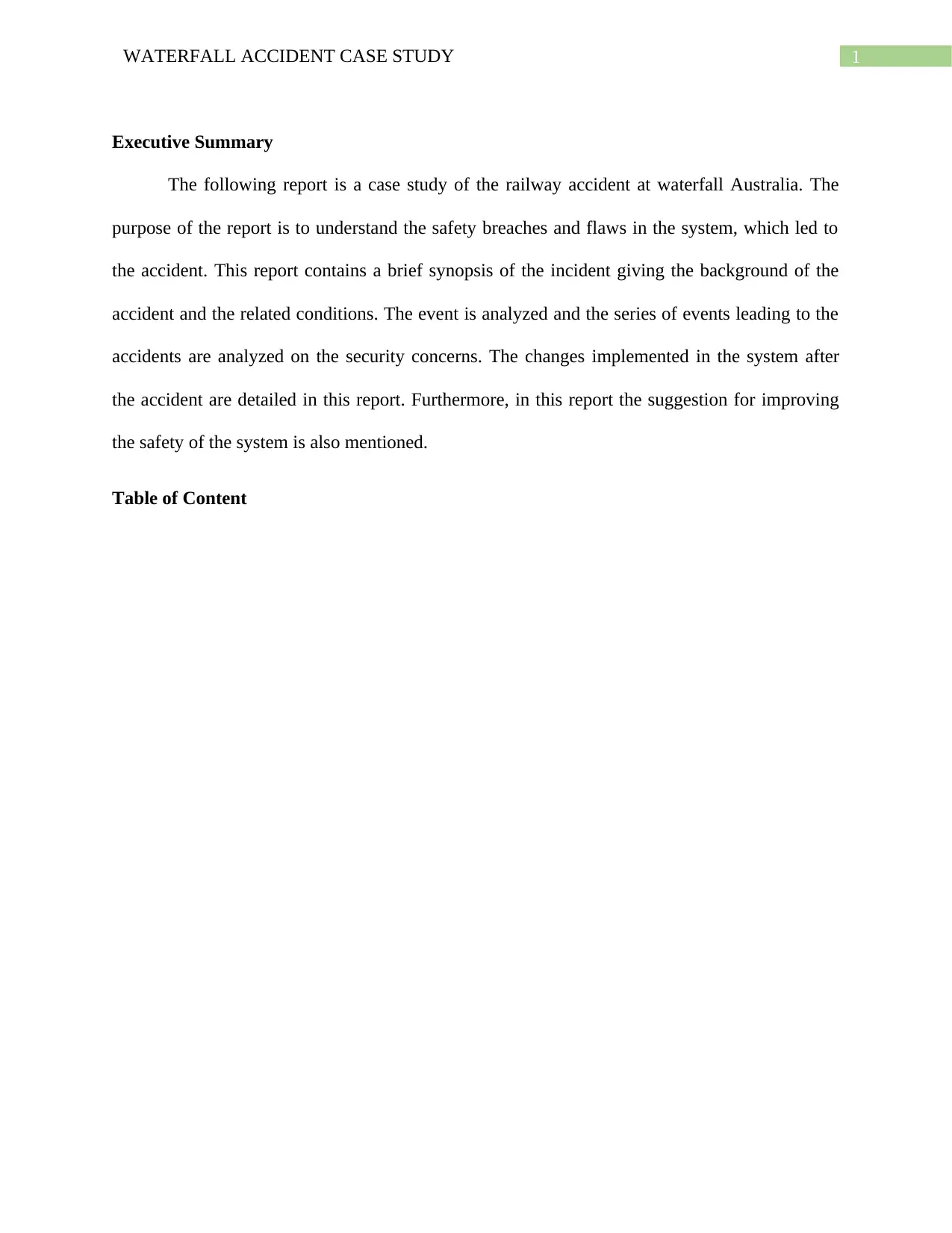
1WATERFALL ACCIDENT CASE STUDY
Executive Summary
The following report is a case study of the railway accident at waterfall Australia. The
purpose of the report is to understand the safety breaches and flaws in the system, which led to
the accident. This report contains a brief synopsis of the incident giving the background of the
accident and the related conditions. The event is analyzed and the series of events leading to the
accidents are analyzed on the security concerns. The changes implemented in the system after
the accident are detailed in this report. Furthermore, in this report the suggestion for improving
the safety of the system is also mentioned.
Table of Content
Executive Summary
The following report is a case study of the railway accident at waterfall Australia. The
purpose of the report is to understand the safety breaches and flaws in the system, which led to
the accident. This report contains a brief synopsis of the incident giving the background of the
accident and the related conditions. The event is analyzed and the series of events leading to the
accidents are analyzed on the security concerns. The changes implemented in the system after
the accident are detailed in this report. Furthermore, in this report the suggestion for improving
the safety of the system is also mentioned.
Table of Content
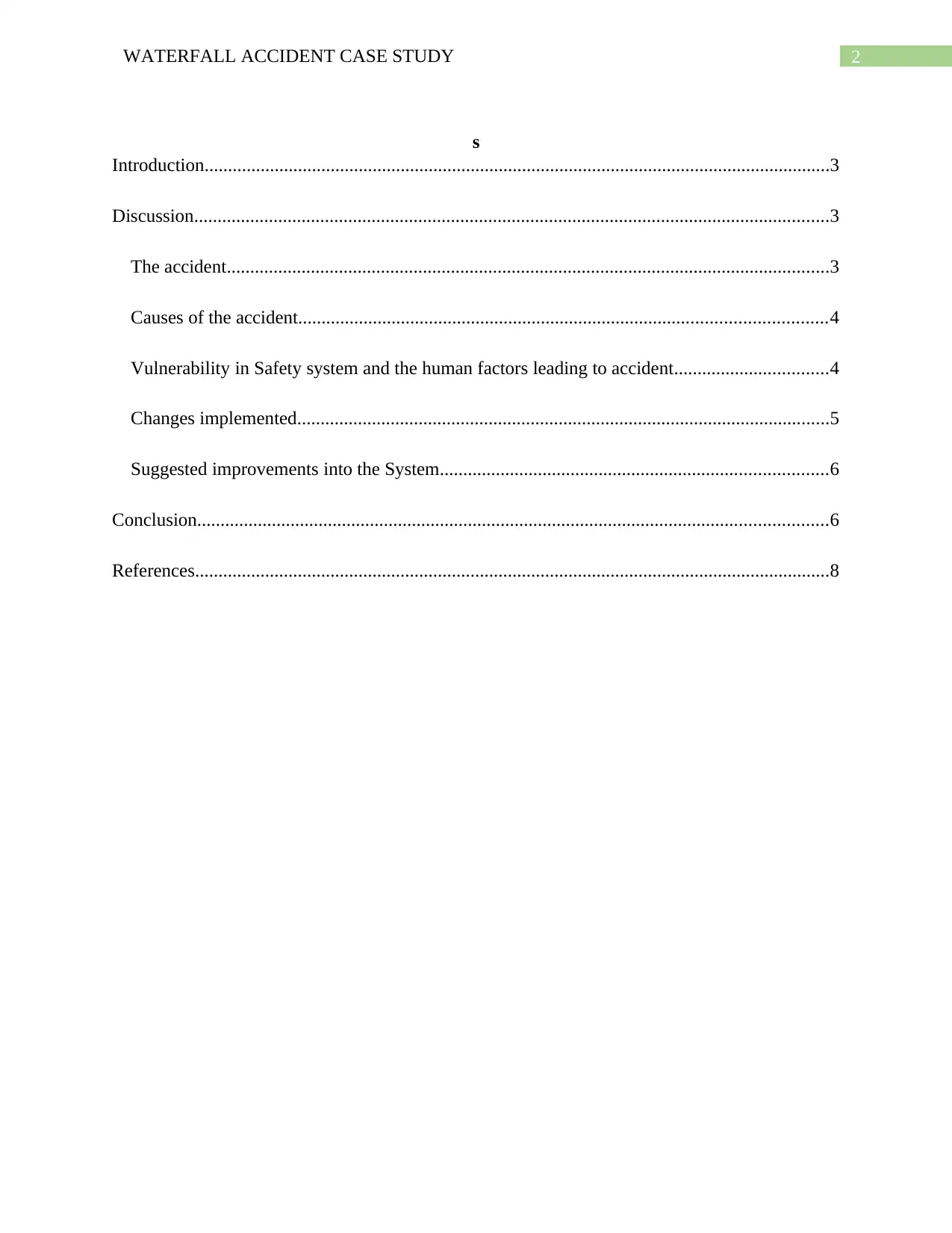
2WATERFALL ACCIDENT CASE STUDY
s
Introduction......................................................................................................................................3
Discussion........................................................................................................................................3
The accident.................................................................................................................................3
Causes of the accident.................................................................................................................4
Vulnerability in Safety system and the human factors leading to accident.................................4
Changes implemented..................................................................................................................5
Suggested improvements into the System...................................................................................6
Conclusion.......................................................................................................................................6
References........................................................................................................................................8
s
Introduction......................................................................................................................................3
Discussion........................................................................................................................................3
The accident.................................................................................................................................3
Causes of the accident.................................................................................................................4
Vulnerability in Safety system and the human factors leading to accident.................................4
Changes implemented..................................................................................................................5
Suggested improvements into the System...................................................................................6
Conclusion.......................................................................................................................................6
References........................................................................................................................................8
⊘ This is a preview!⊘
Do you want full access?
Subscribe today to unlock all pages.

Trusted by 1+ million students worldwide
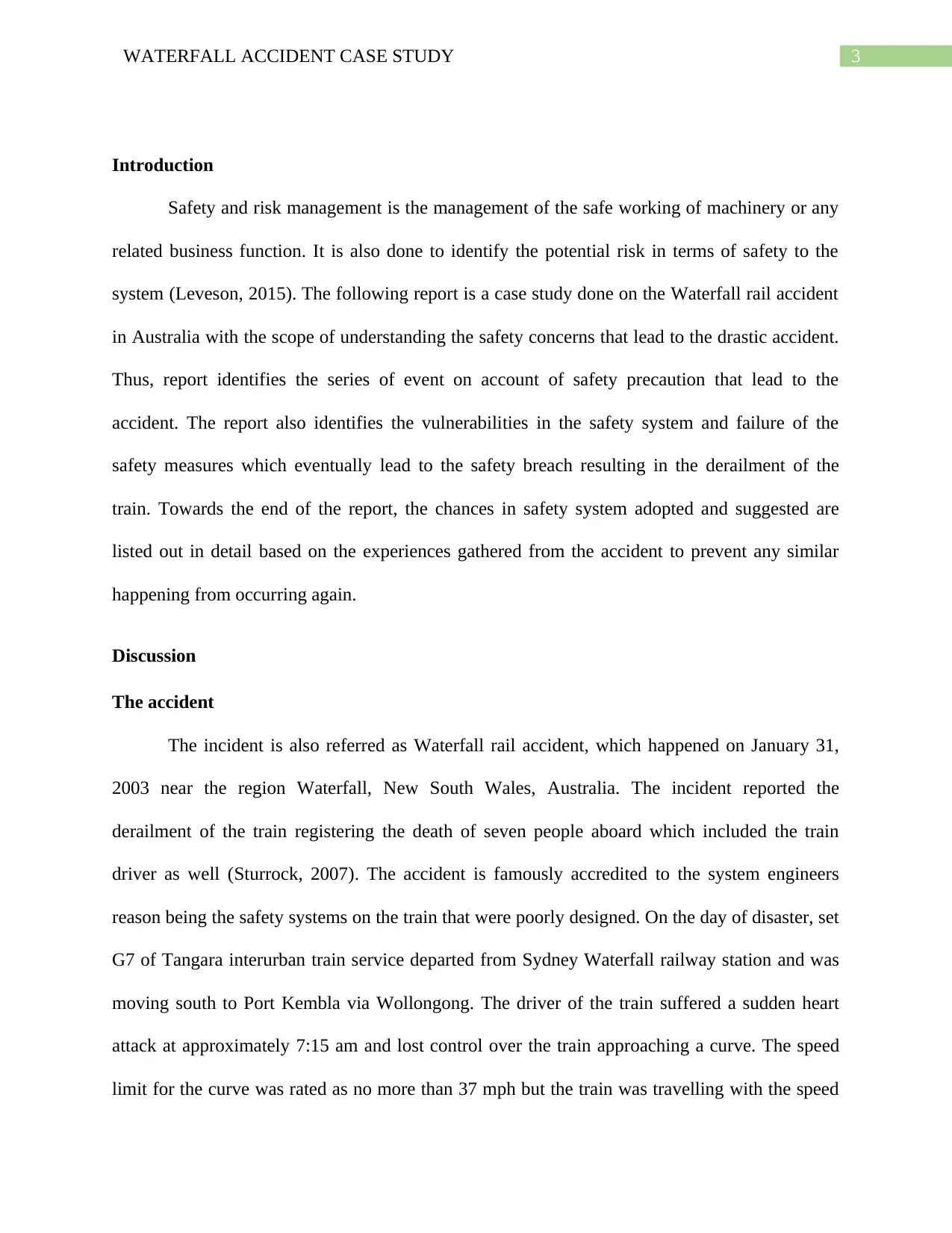
3WATERFALL ACCIDENT CASE STUDY
Introduction
Safety and risk management is the management of the safe working of machinery or any
related business function. It is also done to identify the potential risk in terms of safety to the
system (Leveson, 2015). The following report is a case study done on the Waterfall rail accident
in Australia with the scope of understanding the safety concerns that lead to the drastic accident.
Thus, report identifies the series of event on account of safety precaution that lead to the
accident. The report also identifies the vulnerabilities in the safety system and failure of the
safety measures which eventually lead to the safety breach resulting in the derailment of the
train. Towards the end of the report, the chances in safety system adopted and suggested are
listed out in detail based on the experiences gathered from the accident to prevent any similar
happening from occurring again.
Discussion
The accident
The incident is also referred as Waterfall rail accident, which happened on January 31,
2003 near the region Waterfall, New South Wales, Australia. The incident reported the
derailment of the train registering the death of seven people aboard which included the train
driver as well (Sturrock, 2007). The accident is famously accredited to the system engineers
reason being the safety systems on the train that were poorly designed. On the day of disaster, set
G7 of Tangara interurban train service departed from Sydney Waterfall railway station and was
moving south to Port Kembla via Wollongong. The driver of the train suffered a sudden heart
attack at approximately 7:15 am and lost control over the train approaching a curve. The speed
limit for the curve was rated as no more than 37 mph but the train was travelling with the speed
Introduction
Safety and risk management is the management of the safe working of machinery or any
related business function. It is also done to identify the potential risk in terms of safety to the
system (Leveson, 2015). The following report is a case study done on the Waterfall rail accident
in Australia with the scope of understanding the safety concerns that lead to the drastic accident.
Thus, report identifies the series of event on account of safety precaution that lead to the
accident. The report also identifies the vulnerabilities in the safety system and failure of the
safety measures which eventually lead to the safety breach resulting in the derailment of the
train. Towards the end of the report, the chances in safety system adopted and suggested are
listed out in detail based on the experiences gathered from the accident to prevent any similar
happening from occurring again.
Discussion
The accident
The incident is also referred as Waterfall rail accident, which happened on January 31,
2003 near the region Waterfall, New South Wales, Australia. The incident reported the
derailment of the train registering the death of seven people aboard which included the train
driver as well (Sturrock, 2007). The accident is famously accredited to the system engineers
reason being the safety systems on the train that were poorly designed. On the day of disaster, set
G7 of Tangara interurban train service departed from Sydney Waterfall railway station and was
moving south to Port Kembla via Wollongong. The driver of the train suffered a sudden heart
attack at approximately 7:15 am and lost control over the train approaching a curve. The speed
limit for the curve was rated as no more than 37 mph but the train was travelling with the speed
Paraphrase This Document
Need a fresh take? Get an instant paraphrase of this document with our AI Paraphraser
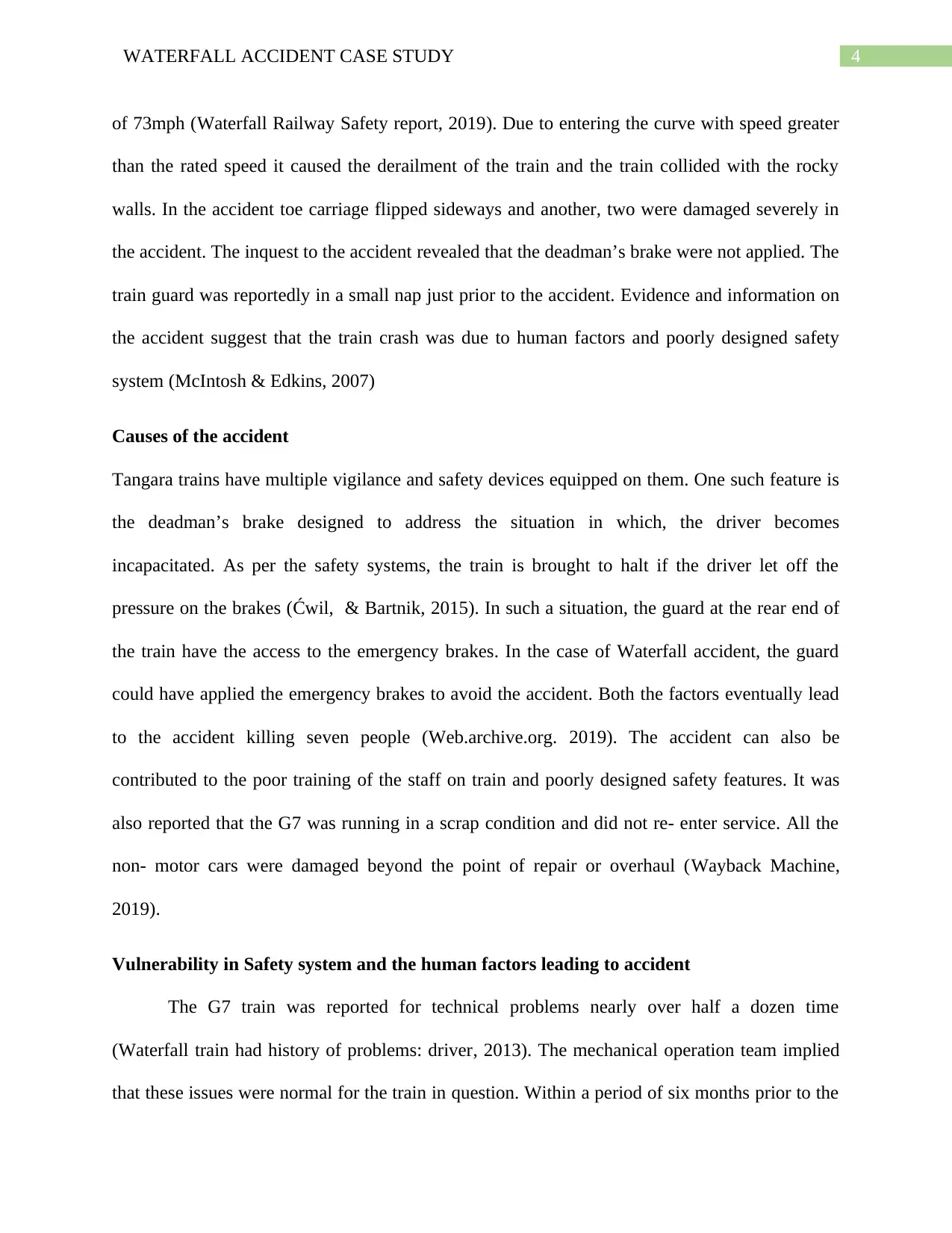
4WATERFALL ACCIDENT CASE STUDY
of 73mph (Waterfall Railway Safety report, 2019). Due to entering the curve with speed greater
than the rated speed it caused the derailment of the train and the train collided with the rocky
walls. In the accident toe carriage flipped sideways and another, two were damaged severely in
the accident. The inquest to the accident revealed that the deadman’s brake were not applied. The
train guard was reportedly in a small nap just prior to the accident. Evidence and information on
the accident suggest that the train crash was due to human factors and poorly designed safety
system (McIntosh & Edkins, 2007)
Causes of the accident
Tangara trains have multiple vigilance and safety devices equipped on them. One such feature is
the deadman’s brake designed to address the situation in which, the driver becomes
incapacitated. As per the safety systems, the train is brought to halt if the driver let off the
pressure on the brakes (Ćwil, & Bartnik, 2015). In such a situation, the guard at the rear end of
the train have the access to the emergency brakes. In the case of Waterfall accident, the guard
could have applied the emergency brakes to avoid the accident. Both the factors eventually lead
to the accident killing seven people (Web.archive.org. 2019). The accident can also be
contributed to the poor training of the staff on train and poorly designed safety features. It was
also reported that the G7 was running in a scrap condition and did not re- enter service. All the
non- motor cars were damaged beyond the point of repair or overhaul (Wayback Machine,
2019).
Vulnerability in Safety system and the human factors leading to accident
The G7 train was reported for technical problems nearly over half a dozen time
(Waterfall train had history of problems: driver, 2013). The mechanical operation team implied
that these issues were normal for the train in question. Within a period of six months prior to the
of 73mph (Waterfall Railway Safety report, 2019). Due to entering the curve with speed greater
than the rated speed it caused the derailment of the train and the train collided with the rocky
walls. In the accident toe carriage flipped sideways and another, two were damaged severely in
the accident. The inquest to the accident revealed that the deadman’s brake were not applied. The
train guard was reportedly in a small nap just prior to the accident. Evidence and information on
the accident suggest that the train crash was due to human factors and poorly designed safety
system (McIntosh & Edkins, 2007)
Causes of the accident
Tangara trains have multiple vigilance and safety devices equipped on them. One such feature is
the deadman’s brake designed to address the situation in which, the driver becomes
incapacitated. As per the safety systems, the train is brought to halt if the driver let off the
pressure on the brakes (Ćwil, & Bartnik, 2015). In such a situation, the guard at the rear end of
the train have the access to the emergency brakes. In the case of Waterfall accident, the guard
could have applied the emergency brakes to avoid the accident. Both the factors eventually lead
to the accident killing seven people (Web.archive.org. 2019). The accident can also be
contributed to the poor training of the staff on train and poorly designed safety features. It was
also reported that the G7 was running in a scrap condition and did not re- enter service. All the
non- motor cars were damaged beyond the point of repair or overhaul (Wayback Machine,
2019).
Vulnerability in Safety system and the human factors leading to accident
The G7 train was reported for technical problems nearly over half a dozen time
(Waterfall train had history of problems: driver, 2013). The mechanical operation team implied
that these issues were normal for the train in question. Within a period of six months prior to the
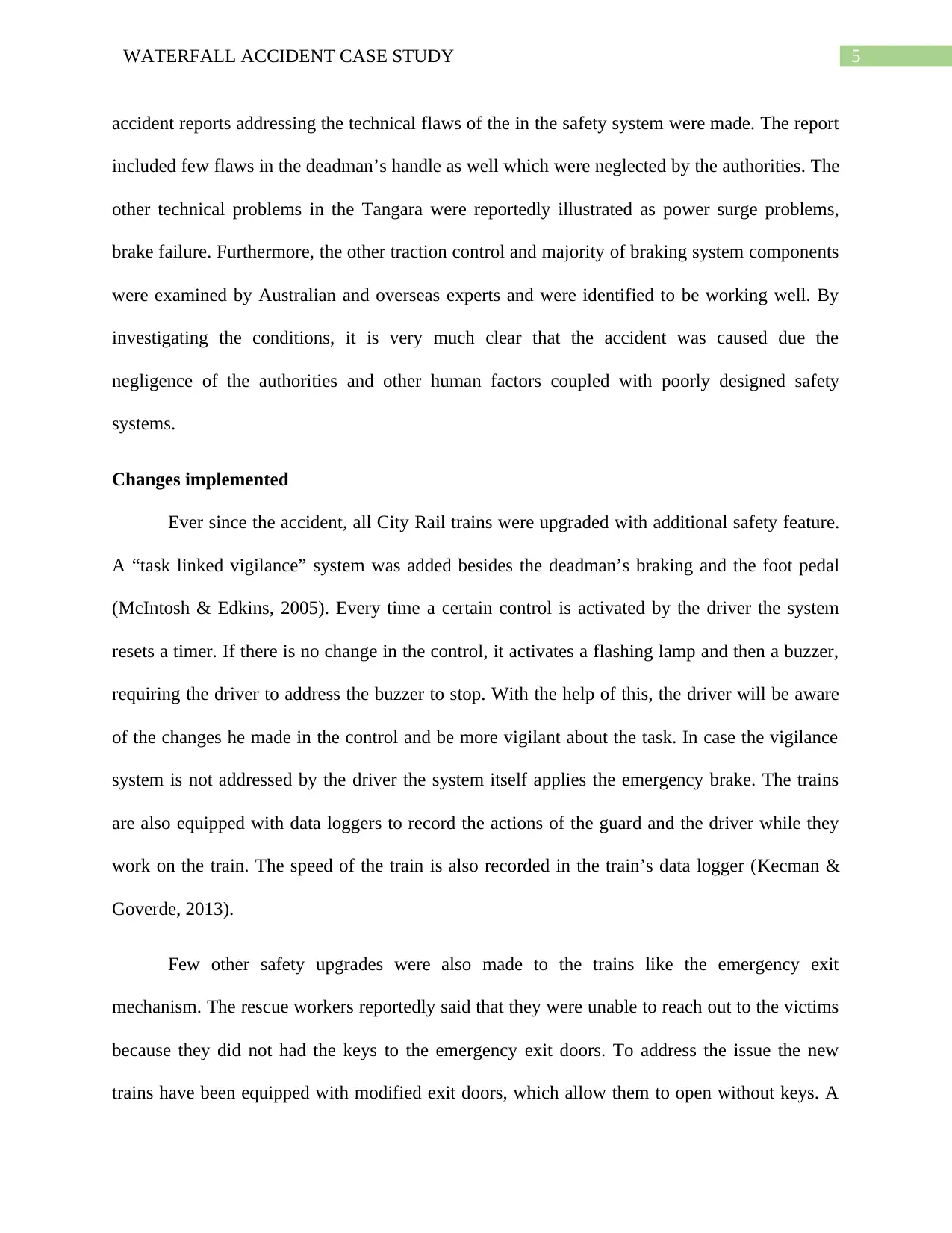
5WATERFALL ACCIDENT CASE STUDY
accident reports addressing the technical flaws of the in the safety system were made. The report
included few flaws in the deadman’s handle as well which were neglected by the authorities. The
other technical problems in the Tangara were reportedly illustrated as power surge problems,
brake failure. Furthermore, the other traction control and majority of braking system components
were examined by Australian and overseas experts and were identified to be working well. By
investigating the conditions, it is very much clear that the accident was caused due the
negligence of the authorities and other human factors coupled with poorly designed safety
systems.
Changes implemented
Ever since the accident, all City Rail trains were upgraded with additional safety feature.
A “task linked vigilance” system was added besides the deadman’s braking and the foot pedal
(McIntosh & Edkins, 2005). Every time a certain control is activated by the driver the system
resets a timer. If there is no change in the control, it activates a flashing lamp and then a buzzer,
requiring the driver to address the buzzer to stop. With the help of this, the driver will be aware
of the changes he made in the control and be more vigilant about the task. In case the vigilance
system is not addressed by the driver the system itself applies the emergency brake. The trains
are also equipped with data loggers to record the actions of the guard and the driver while they
work on the train. The speed of the train is also recorded in the train’s data logger (Kecman &
Goverde, 2013).
Few other safety upgrades were also made to the trains like the emergency exit
mechanism. The rescue workers reportedly said that they were unable to reach out to the victims
because they did not had the keys to the emergency exit doors. To address the issue the new
trains have been equipped with modified exit doors, which allow them to open without keys. A
accident reports addressing the technical flaws of the in the safety system were made. The report
included few flaws in the deadman’s handle as well which were neglected by the authorities. The
other technical problems in the Tangara were reportedly illustrated as power surge problems,
brake failure. Furthermore, the other traction control and majority of braking system components
were examined by Australian and overseas experts and were identified to be working well. By
investigating the conditions, it is very much clear that the accident was caused due the
negligence of the authorities and other human factors coupled with poorly designed safety
systems.
Changes implemented
Ever since the accident, all City Rail trains were upgraded with additional safety feature.
A “task linked vigilance” system was added besides the deadman’s braking and the foot pedal
(McIntosh & Edkins, 2005). Every time a certain control is activated by the driver the system
resets a timer. If there is no change in the control, it activates a flashing lamp and then a buzzer,
requiring the driver to address the buzzer to stop. With the help of this, the driver will be aware
of the changes he made in the control and be more vigilant about the task. In case the vigilance
system is not addressed by the driver the system itself applies the emergency brake. The trains
are also equipped with data loggers to record the actions of the guard and the driver while they
work on the train. The speed of the train is also recorded in the train’s data logger (Kecman &
Goverde, 2013).
Few other safety upgrades were also made to the trains like the emergency exit
mechanism. The rescue workers reportedly said that they were unable to reach out to the victims
because they did not had the keys to the emergency exit doors. To address the issue the new
trains have been equipped with modified exit doors, which allow them to open without keys. A
⊘ This is a preview!⊘
Do you want full access?
Subscribe today to unlock all pages.

Trusted by 1+ million students worldwide
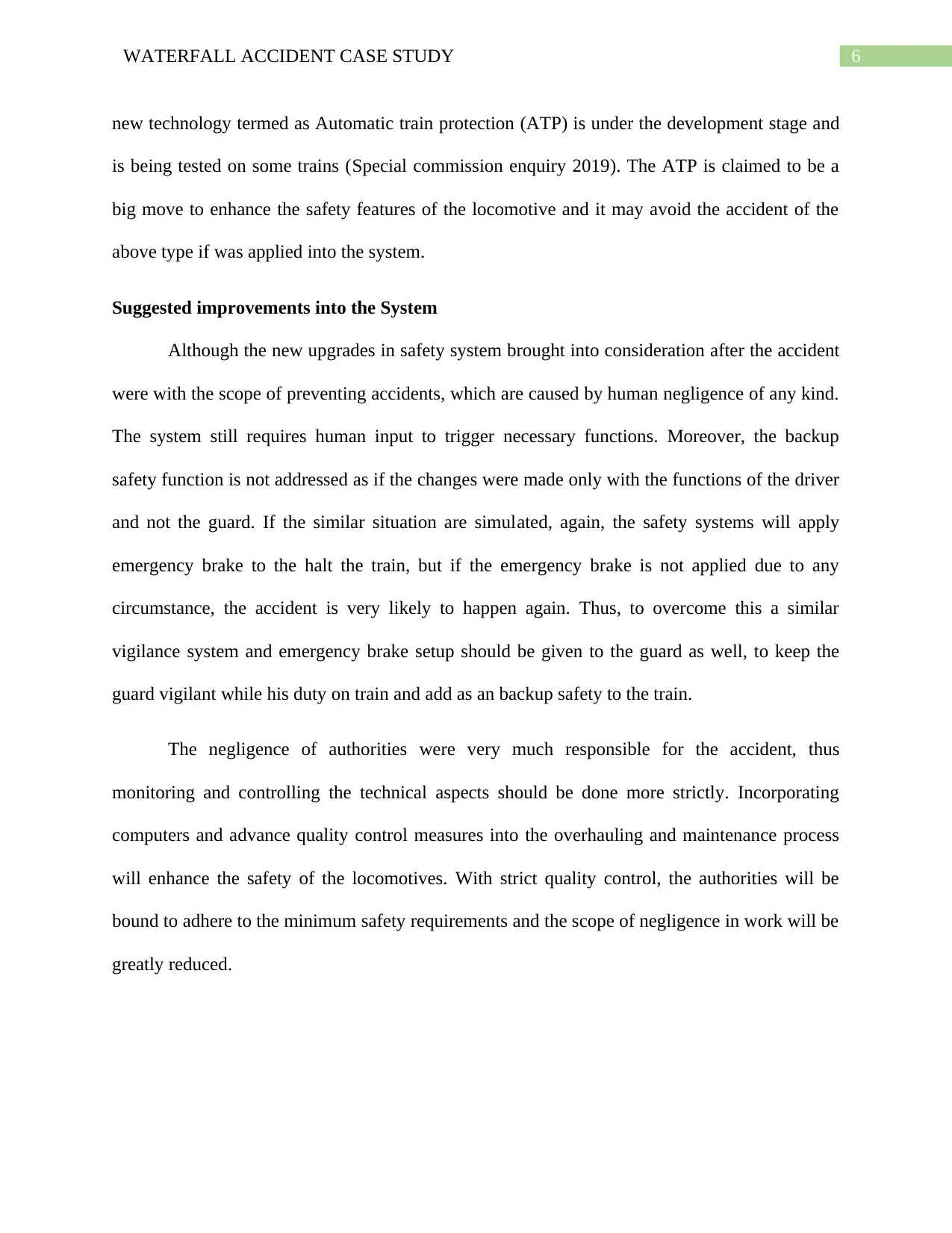
6WATERFALL ACCIDENT CASE STUDY
new technology termed as Automatic train protection (ATP) is under the development stage and
is being tested on some trains (Special commission enquiry 2019). The ATP is claimed to be a
big move to enhance the safety features of the locomotive and it may avoid the accident of the
above type if was applied into the system.
Suggested improvements into the System
Although the new upgrades in safety system brought into consideration after the accident
were with the scope of preventing accidents, which are caused by human negligence of any kind.
The system still requires human input to trigger necessary functions. Moreover, the backup
safety function is not addressed as if the changes were made only with the functions of the driver
and not the guard. If the similar situation are simulated, again, the safety systems will apply
emergency brake to the halt the train, but if the emergency brake is not applied due to any
circumstance, the accident is very likely to happen again. Thus, to overcome this a similar
vigilance system and emergency brake setup should be given to the guard as well, to keep the
guard vigilant while his duty on train and add as an backup safety to the train.
The negligence of authorities were very much responsible for the accident, thus
monitoring and controlling the technical aspects should be done more strictly. Incorporating
computers and advance quality control measures into the overhauling and maintenance process
will enhance the safety of the locomotives. With strict quality control, the authorities will be
bound to adhere to the minimum safety requirements and the scope of negligence in work will be
greatly reduced.
new technology termed as Automatic train protection (ATP) is under the development stage and
is being tested on some trains (Special commission enquiry 2019). The ATP is claimed to be a
big move to enhance the safety features of the locomotive and it may avoid the accident of the
above type if was applied into the system.
Suggested improvements into the System
Although the new upgrades in safety system brought into consideration after the accident
were with the scope of preventing accidents, which are caused by human negligence of any kind.
The system still requires human input to trigger necessary functions. Moreover, the backup
safety function is not addressed as if the changes were made only with the functions of the driver
and not the guard. If the similar situation are simulated, again, the safety systems will apply
emergency brake to the halt the train, but if the emergency brake is not applied due to any
circumstance, the accident is very likely to happen again. Thus, to overcome this a similar
vigilance system and emergency brake setup should be given to the guard as well, to keep the
guard vigilant while his duty on train and add as an backup safety to the train.
The negligence of authorities were very much responsible for the accident, thus
monitoring and controlling the technical aspects should be done more strictly. Incorporating
computers and advance quality control measures into the overhauling and maintenance process
will enhance the safety of the locomotives. With strict quality control, the authorities will be
bound to adhere to the minimum safety requirements and the scope of negligence in work will be
greatly reduced.
Paraphrase This Document
Need a fresh take? Get an instant paraphrase of this document with our AI Paraphraser
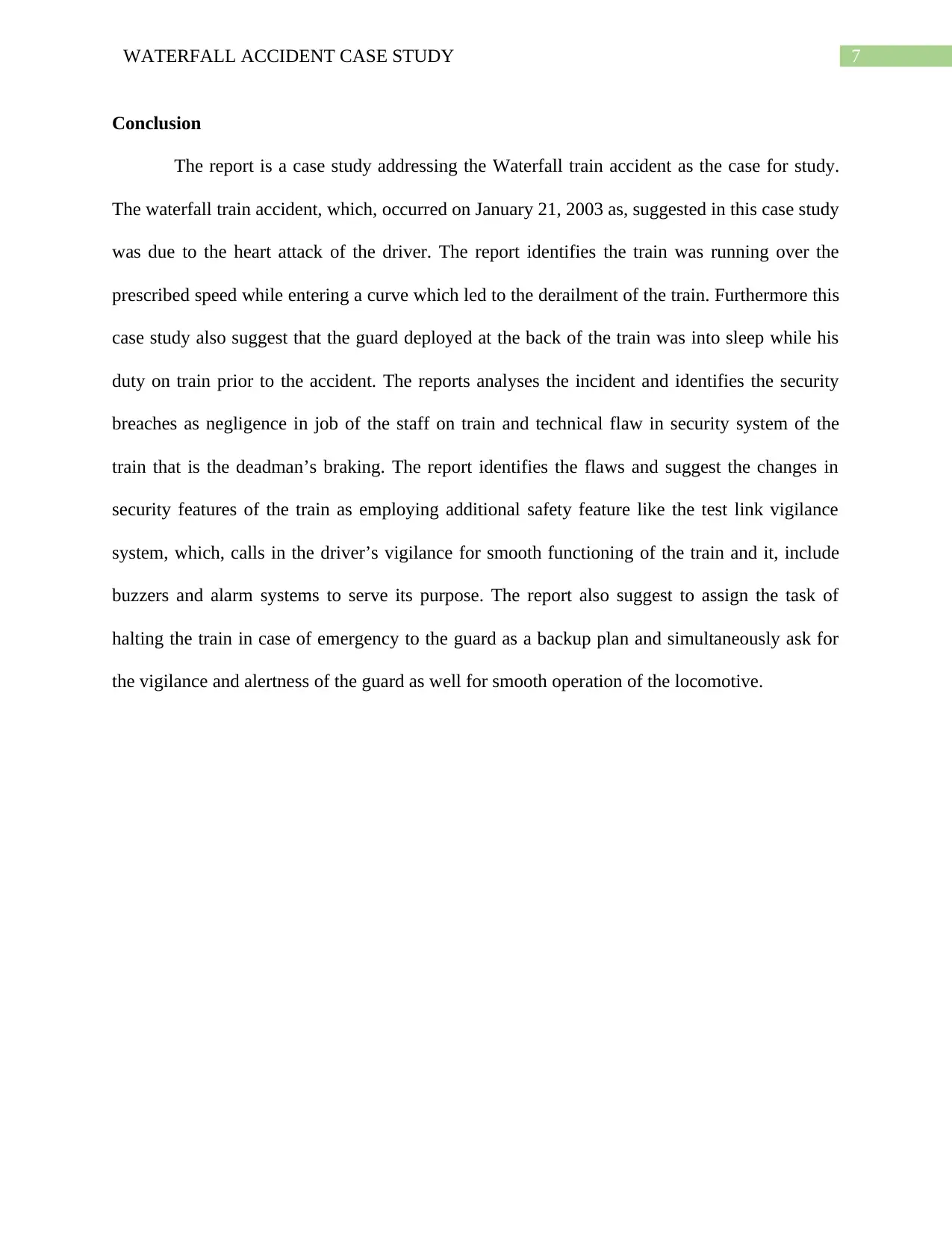
7WATERFALL ACCIDENT CASE STUDY
Conclusion
The report is a case study addressing the Waterfall train accident as the case for study.
The waterfall train accident, which, occurred on January 21, 2003 as, suggested in this case study
was due to the heart attack of the driver. The report identifies the train was running over the
prescribed speed while entering a curve which led to the derailment of the train. Furthermore this
case study also suggest that the guard deployed at the back of the train was into sleep while his
duty on train prior to the accident. The reports analyses the incident and identifies the security
breaches as negligence in job of the staff on train and technical flaw in security system of the
train that is the deadman’s braking. The report identifies the flaws and suggest the changes in
security features of the train as employing additional safety feature like the test link vigilance
system, which, calls in the driver’s vigilance for smooth functioning of the train and it, include
buzzers and alarm systems to serve its purpose. The report also suggest to assign the task of
halting the train in case of emergency to the guard as a backup plan and simultaneously ask for
the vigilance and alertness of the guard as well for smooth operation of the locomotive.
Conclusion
The report is a case study addressing the Waterfall train accident as the case for study.
The waterfall train accident, which, occurred on January 21, 2003 as, suggested in this case study
was due to the heart attack of the driver. The report identifies the train was running over the
prescribed speed while entering a curve which led to the derailment of the train. Furthermore this
case study also suggest that the guard deployed at the back of the train was into sleep while his
duty on train prior to the accident. The reports analyses the incident and identifies the security
breaches as negligence in job of the staff on train and technical flaw in security system of the
train that is the deadman’s braking. The report identifies the flaws and suggest the changes in
security features of the train as employing additional safety feature like the test link vigilance
system, which, calls in the driver’s vigilance for smooth functioning of the train and it, include
buzzers and alarm systems to serve its purpose. The report also suggest to assign the task of
halting the train in case of emergency to the guard as a backup plan and simultaneously ask for
the vigilance and alertness of the guard as well for smooth operation of the locomotive.
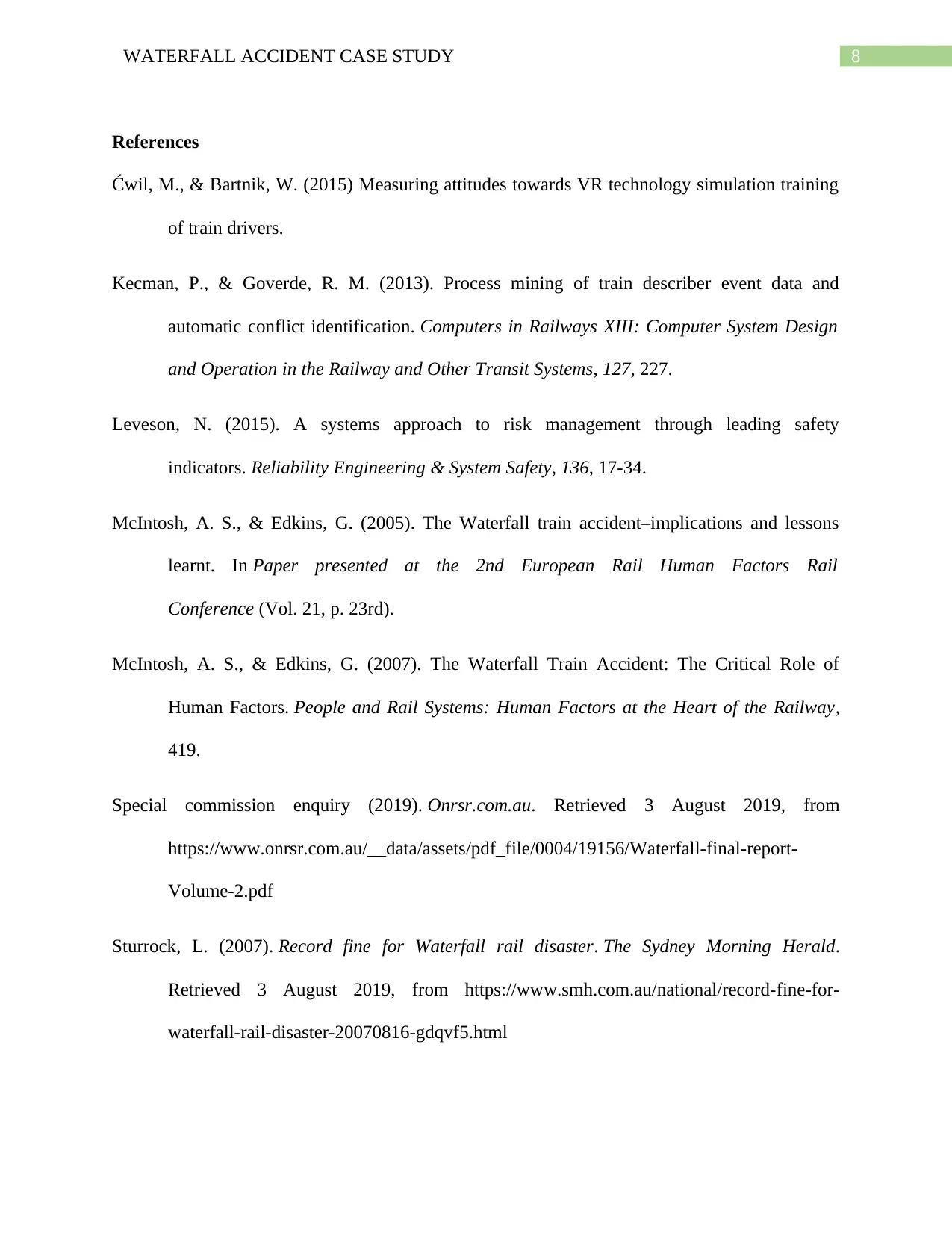
8WATERFALL ACCIDENT CASE STUDY
References
Ćwil, M., & Bartnik, W. (2015) Measuring attitudes towards VR technology simulation training
of train drivers.
Kecman, P., & Goverde, R. M. (2013). Process mining of train describer event data and
automatic conflict identification. Computers in Railways XIII: Computer System Design
and Operation in the Railway and Other Transit Systems, 127, 227.
Leveson, N. (2015). A systems approach to risk management through leading safety
indicators. Reliability Engineering & System Safety, 136, 17-34.
McIntosh, A. S., & Edkins, G. (2005). The Waterfall train accident–implications and lessons
learnt. In Paper presented at the 2nd European Rail Human Factors Rail
Conference (Vol. 21, p. 23rd).
McIntosh, A. S., & Edkins, G. (2007). The Waterfall Train Accident: The Critical Role of
Human Factors. People and Rail Systems: Human Factors at the Heart of the Railway,
419.
Special commission enquiry (2019). Onrsr.com.au. Retrieved 3 August 2019, from
https://www.onrsr.com.au/__data/assets/pdf_file/0004/19156/Waterfall-final-report-
Volume-2.pdf
Sturrock, L. (2007). Record fine for Waterfall rail disaster. The Sydney Morning Herald.
Retrieved 3 August 2019, from https://www.smh.com.au/national/record-fine-for-
waterfall-rail-disaster-20070816-gdqvf5.html
References
Ćwil, M., & Bartnik, W. (2015) Measuring attitudes towards VR technology simulation training
of train drivers.
Kecman, P., & Goverde, R. M. (2013). Process mining of train describer event data and
automatic conflict identification. Computers in Railways XIII: Computer System Design
and Operation in the Railway and Other Transit Systems, 127, 227.
Leveson, N. (2015). A systems approach to risk management through leading safety
indicators. Reliability Engineering & System Safety, 136, 17-34.
McIntosh, A. S., & Edkins, G. (2005). The Waterfall train accident–implications and lessons
learnt. In Paper presented at the 2nd European Rail Human Factors Rail
Conference (Vol. 21, p. 23rd).
McIntosh, A. S., & Edkins, G. (2007). The Waterfall Train Accident: The Critical Role of
Human Factors. People and Rail Systems: Human Factors at the Heart of the Railway,
419.
Special commission enquiry (2019). Onrsr.com.au. Retrieved 3 August 2019, from
https://www.onrsr.com.au/__data/assets/pdf_file/0004/19156/Waterfall-final-report-
Volume-2.pdf
Sturrock, L. (2007). Record fine for Waterfall rail disaster. The Sydney Morning Herald.
Retrieved 3 August 2019, from https://www.smh.com.au/national/record-fine-for-
waterfall-rail-disaster-20070816-gdqvf5.html
⊘ This is a preview!⊘
Do you want full access?
Subscribe today to unlock all pages.

Trusted by 1+ million students worldwide
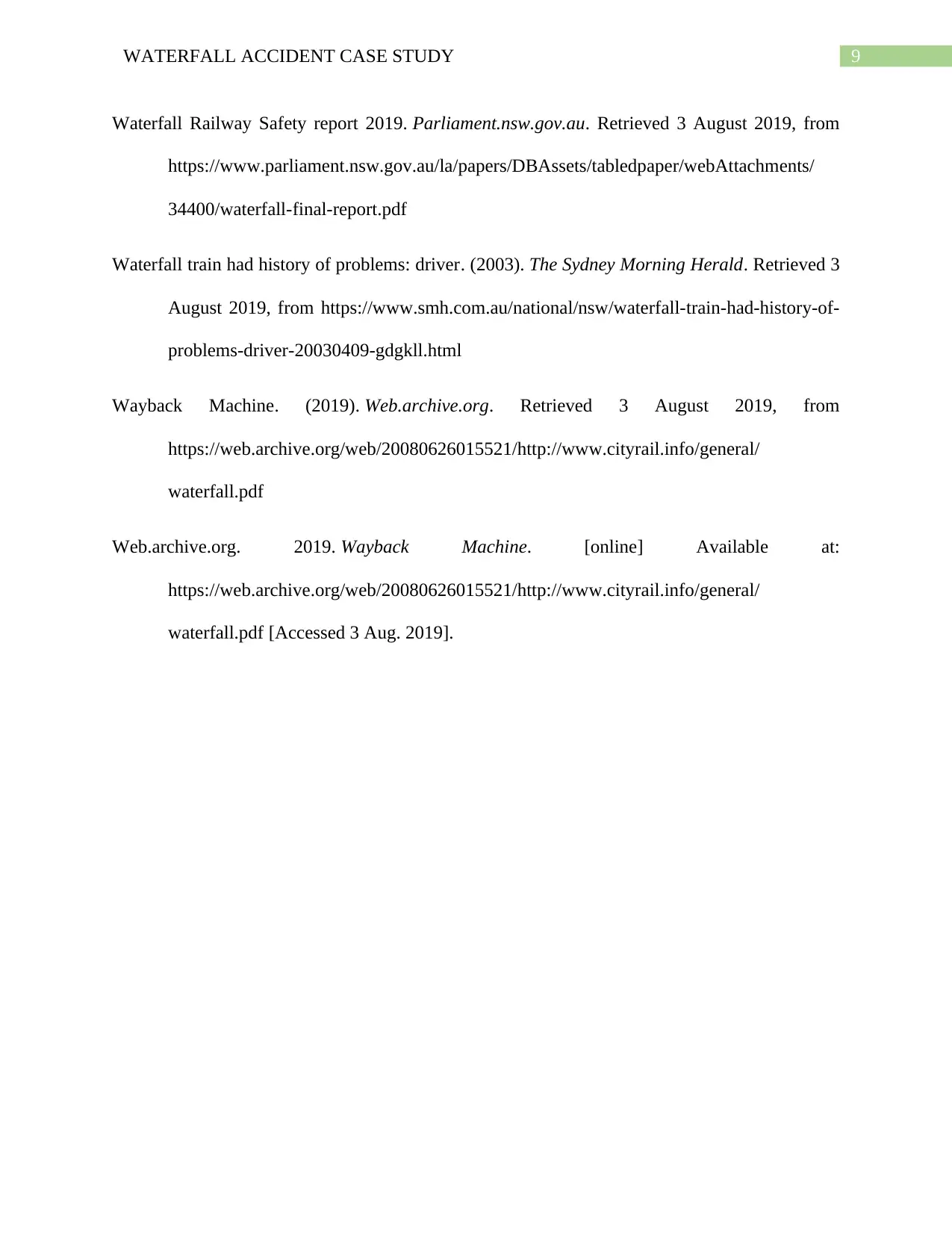
9WATERFALL ACCIDENT CASE STUDY
Waterfall Railway Safety report 2019. Parliament.nsw.gov.au. Retrieved 3 August 2019, from
https://www.parliament.nsw.gov.au/la/papers/DBAssets/tabledpaper/webAttachments/
34400/waterfall-final-report.pdf
Waterfall train had history of problems: driver. (2003). The Sydney Morning Herald. Retrieved 3
August 2019, from https://www.smh.com.au/national/nsw/waterfall-train-had-history-of-
problems-driver-20030409-gdgkll.html
Wayback Machine. (2019). Web.archive.org. Retrieved 3 August 2019, from
https://web.archive.org/web/20080626015521/http://www.cityrail.info/general/
waterfall.pdf
Web.archive.org. 2019. Wayback Machine. [online] Available at:
https://web.archive.org/web/20080626015521/http://www.cityrail.info/general/
waterfall.pdf [Accessed 3 Aug. 2019].
Waterfall Railway Safety report 2019. Parliament.nsw.gov.au. Retrieved 3 August 2019, from
https://www.parliament.nsw.gov.au/la/papers/DBAssets/tabledpaper/webAttachments/
34400/waterfall-final-report.pdf
Waterfall train had history of problems: driver. (2003). The Sydney Morning Herald. Retrieved 3
August 2019, from https://www.smh.com.au/national/nsw/waterfall-train-had-history-of-
problems-driver-20030409-gdgkll.html
Wayback Machine. (2019). Web.archive.org. Retrieved 3 August 2019, from
https://web.archive.org/web/20080626015521/http://www.cityrail.info/general/
waterfall.pdf
Web.archive.org. 2019. Wayback Machine. [online] Available at:
https://web.archive.org/web/20080626015521/http://www.cityrail.info/general/
waterfall.pdf [Accessed 3 Aug. 2019].
1 out of 10
Related Documents
Your All-in-One AI-Powered Toolkit for Academic Success.
+13062052269
info@desklib.com
Available 24*7 on WhatsApp / Email
![[object Object]](/_next/static/media/star-bottom.7253800d.svg)
Unlock your academic potential
Copyright © 2020–2025 A2Z Services. All Rights Reserved. Developed and managed by ZUCOL.





